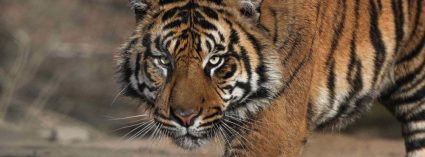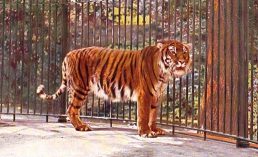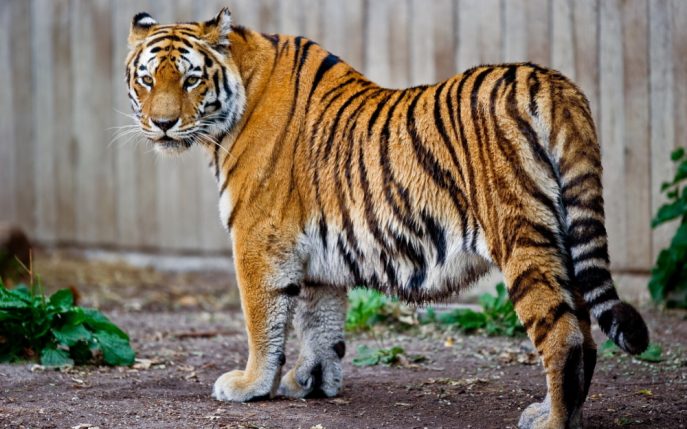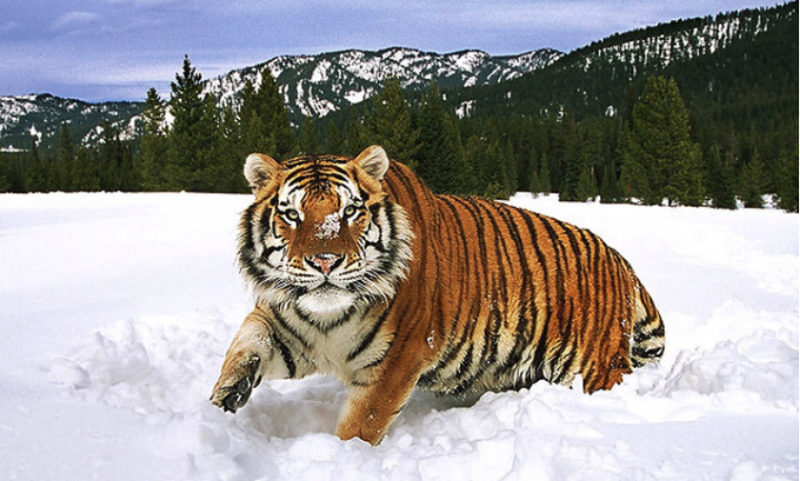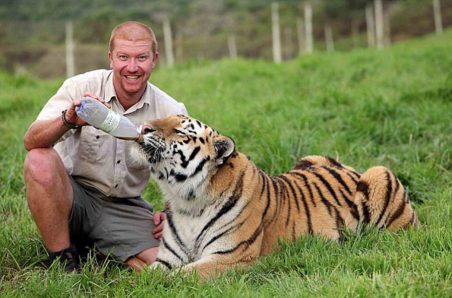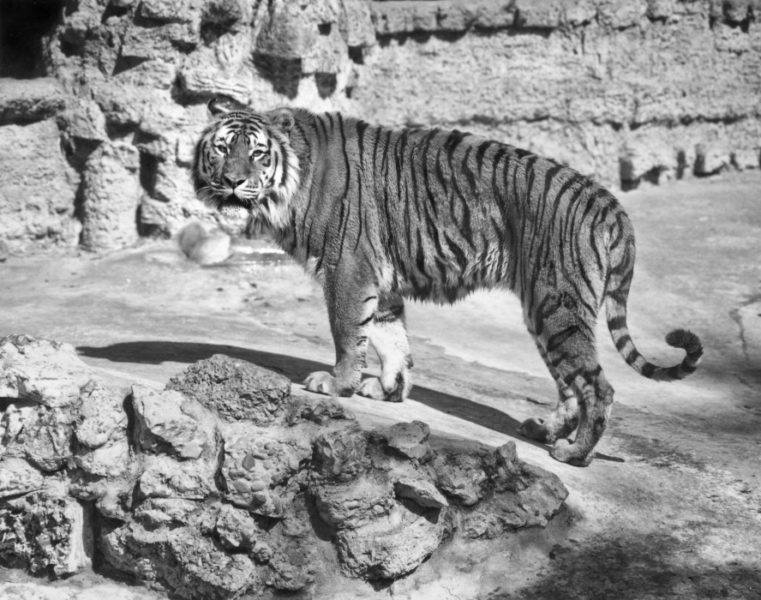The Turanian tiger, a handsome man who was called in Kyrgyzstan “julbars (julbars)” or a stray leopard, cannot be found today in his native habitat. There are no representatives of this subspecies in zoos. Today, paintings and photographs, legends and hunting stories, as well as a few stuffed animals exhibited in museums, tell us about the owner of the tugai forests.
Material Content:
Description of the appearance of the Turanian tiger
The Turanian tiger (Panthera tigris virgata), as scientists were able to establish, was of impressive size. He had a big head, rounded ears. The white mustache impressed with its length, and the whiskers with its splendor.
The tiger moved gracefully and silently, a muscular body allowed him to jump up to 3 m in height and up to 6 m in length. At short distances, pursuing prey, these representatives of the cat family could reach speeds of up to 80 km / h.
The following parameters were characteristic of the beast:
- The body length reached 2.7 m in males and 2.5 m in females. The tail was about 1 m.
- Height at withers - up to 1.2 m.
- The tiger weighed about 210-230 kg.
Dzhulbars did not change the color of his coat radically, depending on the time of year. But the winter color was still different from the summer one. The latter was brighter, rich red, in winter dull ocher shades prevailed.
Features and habitat
The habitat of the Turanian tiger was vast. Predators met in the foothills of the Tien Shan, were found in Turkmenistan and Uzbekistan, Kyrgyzstan and Kazakhstan. They were hunted in Pakistan and Afghanistan, Iraq and Turkey.
The name of the subspecies itself is associated with geography. A large number of predators lived on the Turan plain of Kazakhstan. But tigers lived both on the coast of the Caspian Sea and on the lands of Transcaucasia.So these predators were also called “Caspian tigers” and “Transcaucasian”. In both cases we are talking about the Turanian subspecies.
The predator chose a place for life where trees and shrubs densely grew, there was enough prey, there were rivers or streams with running water. If the thickets of grass turned out to be too high, the beast, in order to examine the prey, made a stand on its hind legs.
Tigers preferred the lowlands, but could also be found in mountainous areas, at an altitude of up to 4 km above sea level.
Character and lifestyle
Observations of the life of the Turanian tiger turned out to be very interesting. Although the beast was called a “vagrant”, he was not at all inclined to change his habitat and knew well “his” territory. On it he had up to a dozen rookeries.
Some of them were located on the hills and played the role of a kind of "viewing platforms", from where it was convenient to observe the surroundings. Others were located in remote places. There, having fed up, the tiger was resting, not fearing that someone would disturb him.
Striped predators loved to swim, especially in the summer, fleeing from the heat. But the river was for the tiger and the "food base", he knew how to catch waterfowl with his sharp claws, ate crayfish and frogs.
The predator was not afraid of Morozov, but it was rather difficult for him to move on loose snow. By the way, he also “bathed” in the snow, getting rid of his characteristic smell.
The Turanian tiger was not a night hunter, like some representatives of the cat family. He could overtake prey at any time of the day. Usually he was waiting for her in an ambush, letting them reach a distance of 20-30 m. If, as a result of a rapid throw, the victim could not be overtaken, the tiger did not pursue her. Waiting for a new opportune moment.
Having caught big game, the predator stopped hunting and proceeded to a meal. If the prey was shallow, he tried to kill several animals at once in order to get enough.
The Turanian tiger did not climb trees, except that he could run up the inclined trunk. Therefore, there are cases when people escaped from a predator in this way - riding a tree branch.
Hunting in the thicket, the tiger not only got up on its hind legs, but could also jump several meters in height to look around.
Nature provided the Turanian tiger with a good disguise. When he ran, the stripes on his back merged, the beast seemed monotonous - brown. Often this color merged with the landscape.
Thanks to great power, an adult tiger could drag a dead cow or horse, a camel to a secluded place. And the boar carried in his teeth, holding his head high.
They say about cats that they have "nine lives." A similar representative of the feline family, the Turanian tiger, was distinguished by similar vitality. Even being seriously wounded, he could hide from the pursuer or, conversely, engage in a desperate battle with him.
Although predators sought a solitary lifestyle, they nevertheless created small families: a male and 2-3 females. Such males did not allow other males to "their" territory. The exception was the growing cubs of this sex.
In search of prey, a tiger walked about 10 km per day, moving in a circle, returning to the same place, doing once every few weeks. The hunters correctly identified the characteristic tiger paths. Tigers avoided difficult sections of the road, skillfully avoiding natural obstacles. If winters were snowy, the tiger passed under the trees, on whose branches snow lingered. Accordingly, there was less of it on earth.
If prey became scarce, the predator could travel long distances in search of food. So, in the 19th century, the Turanian tiger reached Altai. The beast perfectly adapted to changing conditions, and survived no matter what.
About the notorious growl of a tiger: in a familiar area, a striped predator gave voice during mating or during a fight. The rest of the time the animals were silent.
Tiger Diet
Wild pigs and deer were the favorite food of the Turanian tiger. Wild boars were especially tasty. The predator hunted them both in the Transcaucasus and in Central Asia.
Prey could be wolves, bears, and any domestic animals - from dogs to camels.
The tiger preferred to eat fresh meat, but in the famine it did not disdain any food - it ate carrion, hunted birds and turtles, frogs and rats, even insects, such as locusts.
In its range, the tiger was the master of the forest; for him there was no “too tough” prey.
Being full, he quickly gained weight, his fat layer reached 6 cm. He could starve for quite a long time - more than a week. But then he already pounced on any victim - livestock and even people.
The tiger tracked the future prey, creeping up, coming up from the leeward side, and promptly attacked. He could imitate the voices of roaring deers, luring their relatives to him. He followed the herd of wild boar and lifted the beating off animal. At one time, the tiger could get enough of a piglet or a small roe deer, eating larger prey in 2-3 days. After this, a long rest followed, the tiger only occasionally left the bed to get drunk.
Animal breeding
Most often, courtship games began in the winter. Fights between males were rare. Usually there were enough threats - snarling, aggressive behavior.
The male fertilized 2 or more females. The mother took care of the cubs exclusively. In secret, inaccessible places, she arranged a lair and for about 3 months she was carrying cubs. From 1 to 3 cubs were born.
At first they drank mother’s milk, and, after several months, tried to eat the meat brought by her. Six-month-old individuals have already taken part in the hunt, starting from the year, they tried to hunt on their own, but they reached maturity by 2 years.
Causes of extinction
Turanian tiger populations in the 19th century were significant. In total, there were about 10 thousand individuals. But, 100 years later, by the middle of the 20th century, scientists were forced to talk about the extinct subspecies of tigers.
There were several reasons for this. First, the forests in which the striped predators lived and found their livelihood were destroyed. Man mastered the riverbeds, cities, villages appeared. The second - people declared war on the Turanian tigers, because the striped robbers raided livestock.
The hunters approached the predators, hiding in a strong cage. And when the beast attacked, they shot him at point blank range.
Bonuses were relied upon for the killed tigers. Soldiers and Cossacks were specially sent to hunt. Officers encouraged this activity. It was believed that if a person overcomes fear, kills a tiger, then he can cope with any enemy.
Until what year could the Turanian tiger be found? A manual beast in 1913 lived in the city of Verny at a local forester. In 1928, the beauty of predators was admired by Leon Trotsky - he then lived in Alma-Ata. In 1906, Prince Golitsyn killed the last Turanian tiger in the vicinity of Tashkent. They made a scarecrow out of the beast's skin, which was later destroyed by fire.
Officially it is believed that the last individual of this subspecies was killed in 1933. It happened on the banks of the Syr Darya.
But there is evidence that in Tajikistan the Turanian tiger was seen in 1954, and in Kyrgyzstan in 1980.
Revival project
Today, a program has been developed whose purpose is to restore the population of the Turanian tiger - reintroduction. It involves the relocation of animals of a particular subspecies to where they once inhabited.
In this case, it is planned to return the Turanian tiger to Kazakhstan. This topic was devoted to the International Conference, which was held in 2014 in Astana. A safe environment, natural reserve will be created for tigers, and a food base will be prepared.
For this, Bukhara deer will be brought to the territory of the national park. The program is designed for 15 years. This period includes the preparation of the territory, the settlement of its tigers, monitoring them.
Relationship with people
The Turanian tiger did not show much aggression towards humans until it was touched. He often watched the actions of people, approached their homes, hunting lodges, but if he attacked, then mainly dogs and livestock.
The battle of people and the beast took place during the hunt, especially when the tiger was forced to protect its cubs.
Cases of cannibalism for no apparent reason were extremely rare. It is known that a tiger attacked a woman moving along “his territory” (she was collecting firewood). Another time, an officer in the Syr Darya region became a victim. When the comrades found the body, little was left of it.
But much more often the tiger eschews a person, because the danger is only a wounded or sick animal, if it is being pursued. There are cases when tigers showed friendliness when meeting people, or calmly passed by.
Legends and facts from the life of a predator
Scientists believe that the Turanian and Amur tigers had a common ancestor (supposedly Caspian) and once lived in the same places. Today, Amur tigers can be considered descendants of Turan.
The image of a striped predator is found on Central Asian fabrics and carpets. In Samarkand, a painted tiger can be seen on the facade of a mosque.
The hunters, having sold the hide of a formidable beast, kept their claws for themselves. It was believed that if they were sewn to clothes, they would drive away evil forces.
Those who dealt with Turanian tigers told amazing stories about them. A predator could press a person to the ground, demonstrating its power over him, and then release it. There were cases when wounded and sick tigers sought help from people.


